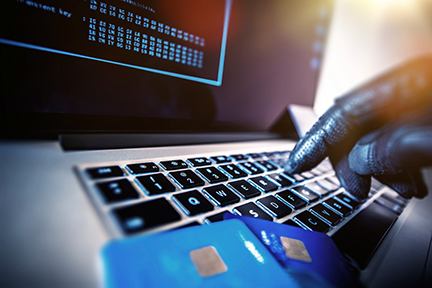Credit card fraud in America accounts for 47 percent of the worldwide total, and 76 percent of the data breaches[1].
In 2014, approximately 31.8 million Americans had their credit cards breached, a 300 percent rise in one year.
It seems that as fast as technology moves to protect us, hackers are just as fervently seeking ways to overcome the heightened layers of credit card security. EMV chip cards, for example, are designed to help consumers, but the reality is, people have to be smarter about identity theft prevention.
Here are a 9 easy ways to protect yourself from credit card fraud.
 Don’t click so fast.
Don’t click so fast.
Phishers are scammers who send emails to slip into your network by enticing you to click on an offer. When you do, you enable them to infuse malware into your device. Then, it’s like you opened the door and welcomed them in. They’re free to poke around in your system, searching for account information. Before you click, look at who sent the email. If you don’t recognize the sender, delete it.
 Choose credit over debit.
Choose credit over debit.
A debit purchase requires you to enter a PIN. If the hacker gets your PIN, he has access to your bank accounts. By choosing the credit option, you have the fraud protection that goes with credit card purchases.
 Use strong passwords and change frequently.
Use strong passwords and change frequently.
This is a big one. Choose your passwords carefully. Don’t use a birthday, a pet’s name, or something that is easy for a hacker to identify by just looking at your Facebook page. Use a combination of letters, numbers, and symbols. Don’t use the same password for all of your accounts. While it’s convenient for you, it’s also convenient for the hacker. And change your passwords every month. Learn more tips for creating a strong password here.
 Log out.
Log out.
When you’re making a purchase or payment online, be sure to log out before you end the session.
 Monitor your information.
Monitor your information.
Check your bank and credit card statements weekly so you can quickly identify fraudulent use. Look at your credit report to see if anyone has opened accounts in your name. If you detect a questionable entry on any of these statements, report it immediately.
 Be careful with phone purchases.
Be careful with phone purchases.
Never give your credit card or banking information to someone who solicits you on the phone. As trustworthy and sincere as they may seem, remember that hackers can be highly skilled. Ask for a phone number and website where you can verify the company that wants your money.
 Carry your cards separately.
Carry your cards separately.
Keep your credit and debt cards in a separate case, not your wallet, so that if your wallet is lost or stolen, your cards aren’t vulnerable. You will usually not need every credit card, so only carry those that you expect to use.
 Advise your card issuer when you’re traveling.
Advise your card issuer when you’re traveling.
Credit card companies and banks may be watching your purchasing pattern. If they see your card being used outside of your normal geographic area, you should get an alert (“should” being the operative word). To prevent delays when you’re traveling, advise the card issuer that you will be using the card in a certain region.
 Shred your paper trail.
Shred your paper trail.
I never throw away anything with my personal information on it, and you shouldn’t either. Shred all of your paper statements, credit card offers, and anything with your name and address (I even remove and shred the mailing portion of my magazines and catalogs, including the order form).
No one can protect your identity like you can. Be smart about the way you make and manage your purchases. Hackers are clever, but lazy. If they hit a wall with your identity theft protection, they’ll move on to an easier target.
[1] Barclays’ Security in Payments: A Look into Fraud, Fraud Prevention, & the Future, May 22, 2015
Have you been a victim of credit card fraud? What are you doing to protect yourself? Share your tips with us on Twitter @LTronCorp.
About the Author:
 Gayle DeRose is proud to be the COO and Marketing Director for L-Tron. Her passions are serving customers, all things creative and her family. She has been with the company for over 20 years, continuously developing her expertise in operations & marketing, as well as the strategy, implementation and ongoing training required to deliver the exceptional service standard L-Tron models today.
Gayle DeRose is proud to be the COO and Marketing Director for L-Tron. Her passions are serving customers, all things creative and her family. She has been with the company for over 20 years, continuously developing her expertise in operations & marketing, as well as the strategy, implementation and ongoing training required to deliver the exceptional service standard L-Tron models today.













